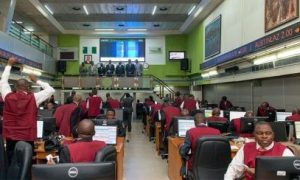The Monetary Policy Committee (MPC) of the Central Bank of Nigeria (CBN) is set to meet on 22 and 23 July, 2024, for their fourth meeting of the year. As expected, the MPC will assess recent developments in the global and domestic economies since the last policy meeting. For the global economy, we note that interest rates have remained elevated. However, central banks are beginning to pivot to monetary policy easing as global inflation approaches set targets. On the domestic front, we highlight the resilient economic growth but still elevated inflationary pressures indicated in the further uptick in the June inflation print (34.19% y/y). Additionally, we point out the increased volatility in the naira primarily due to muted FPI inflows and frail FX interventions from the CBN. Therefore, we expect the MPC to maintain a tight monetary policy stance at its upcoming meeting to (1) reduce the negative real rate of return, (2) manage inflation expectations, and (3) stabilize the naira. As a result, we expect the CBN to raise the MPR by 100 basis points to 27.25% in its meeting next week.
Oil Sector to Boost GDP Growth in Q2-24
Based on recent economic events and data, business activities in the non-oil sector have remained lacklustre, reflecting a weak consumer demand amid higher cost pressures and tight financial conditions. Indeed, the Stanbic IBTC Composite PMI averaged 51.1 points in Q2-24, a moderation from the 52.2 points recorded in Q1-24. Specifically, the Composite PMI fell to its lowest level in seven months to 50.1 points in June after improving in May (52.1 vs April: 51.1). This hints that growth in the non-oil sector has remained subdued, synchronizing neatly with our estimate of +2.89% y/y in Q2-24 (Q1-24: +2.80% y/y | Q2-23 +3.58% y/y).
For the oil sector, we point out that domestic oil production has increased modestly in recent months after declining to 1.43 mb/d (including condensates) in March. Precisely, oil production increased consecutively in Q2-24, rising from 1.45 mb/d in April to 1.50 mb/d in June, primarily due to resumed operations in oil terminals that were shut down for repairs as well as the commencement of oil production activities in new oil fields. Overall, oil production averaged 1.47 mb/d in Q2-24, trailing behind the previous quarter (Q1-24: 1.54 mb/d) but significantly above the level recorded in Q2-23 (1.39 mb/d). Consequently, we estimate an oil sector growth rate of 22.95% y/y in Q2-24 (Q1-24: +5.11% y/y | Q2-23: -13.43%y/y) underpinned by the low base from the prior year. Altogether, we estimate GDP growth of 3.96% y/y in Q2-24 (Q1-24: +2.98% y/y | Q2-23: +2.51% y/y). Nevertheless, we retain our GDP growth forecast for 2024E at 3.20% y/y. We expect the MPC to acknowledge the growth in the oil and non-oil sectors in Q1-24 despite challenges posed by low Foreign Direct Investment, high inflationary pressures and tight financial conditions. However, we expect the MPC to maintain an optimistic outlook while retaining its average growth forecast of 3.38% y/y for 2024E.
Headline Inflation Rises Further in June on Higher Food Prices
Headline inflation increased further in June, rising by 24bps to 34.19% y/y (May: 33.95% y/y) primarily due to the exchange rate pass-through on commodity prices, high energy prices and increased food shortages. Similarly, the month-on-month inflation print came in at 2.31% m/m (+2.14% y/y), owing to higher food prices following the increased consumer demand from the Eid-el-Kabir celebration. As a result, food inflation rose by 27bps to 2.55% m/m (May: +2.28% m/m), pushing the y/y rate higher to 40.87% (May: 40.66% y/y). Similarly, core inflation rose, albeit moderately, by 5bps to 2.06% m/m (May: +2.01% m/m) following the slight naira depreciation amid a slower increase in energy prices. On a year-on-year basis, core inflation rose by 36bps to 27.40% y/y. We expect the Committee to point out the persisting inflationary pressures, attributing it to increased food prices and the depreciation of the naira. We also expect the MPC to acknowledge the recent efforts of the government to increase food supplies and slow down food prices, including the distribution of fertilizers and the removal of import duty on specific food commodities.
Naira Depreciates on Weak FX Liquidity
The naira has remained volatile in recent weeks mainly due to the tight liquidity in the FX market. Precisely, the CBN sustained its weak FX intervention, while foreign investors stayed on the sidelines mainly due to convertibility risk concerns, causing FX liquidity to dwindle. Indeed, total inflows into NAFEM in June fell significantly by 53.7% m/m to USD1.45 billion (May: USD3.12 billion) – the lowest since January 2024 (USD1.03 billion). Breaking it down, inflows from international sources fell by 55.9% m/m to USD434.10 million (May: USD984.4 million), while inflows from local sources declined by 52.6% m/m to USD1.01 billion (May: USD2.14 billion), with no recorded inflows from the CBN. Consequently, the NAFEM rate weakened by 3.5% to an average of NGN1,487.60/USD in June (May: NGN1,435.87/USD). So far in July, whilst liquidity improved mildly aligned with the CBN supplying USD122.67 million, the naira remains under pressure and approaching the NGN1,600.00/USD handle as demand for FX continues to outweigh supply.
Conversely, there has been sustained accretion to the FX reserves as the balance reached a 16-month high of USD35.77 billion (as of 16 July), primarily supported by the disbursement of the first tranche (USD750.00 million) of the Development for Financing (DPF) loan (USD1.50 billion) from the World Bank, improved earnings from oil exports, FX purchases from FPIs and increased remittances. We expect the MPC to acknowledge the increased naira volatility, ascribing it to rising demand whilst encouraging the CBN to increase its efforts to boost liquidity in the FX market and stabilize the naira.
Rate Cuts Imminent in Advanced Economies
Inflation in the advanced economies has continued to moderate closer to set targets, drawing the period of monetary policy easing nearer. The European Central Bank initiated its first rate cut in June, and the US Federal Reserve and the Bank of England are expected to follow suit at their September meetings.
Specifically, in June, the Federal Open Market Committee (FOMC) voted to keep the federal funds rate target range steady at 5.25%—5.50% for the seventh consecutive meeting. Although the Committee acknowledged progress toward the 2.0% inflation target, it stated that reducing the policy rate would be premature until there is greater confidence in sustainably achieving this target. Notably, the Committee projected only one interest rate cut in 2024, reflecting a more conservative outlook than the three cuts projected at the March meeting. Nonetheless, recent economic data releases, specifically inflation, which moderated to 3.0% y/y (May: +3.3% y/y) and the uptick in the unemployment rate to 4.1% (May: +4.0%) in June, suggest that the US economy is losing steam as interest rates remain elevated. Whilst we expect the Committee to hold its policy rate steady at the July meeting, we anticipate a more dovish tone from the Committee, signalling a possible rate cut in September. This synchronizes neatly with market expectations as the CME FedWatch tool indicates a probability of 95.3% that the Fed will keep rates unchanged at the July policy meeting and a 91.7% chance of a rate cut in September.
Similarly, the Monetary Policy Committee (MPC) of the Bank of England (BoE) retained the monetary policy rate at 5.25% at their June monetary policy meeting despite headline inflation reaching the 2.0% target in May (April: +2.3% y/y). The decision to hold the rate steady against a cut was regarded as “finely balanced”, indicating insufficient evidence to underpin a rate cut. This was primarily because services and core inflation remained elevated amid the moderation in headline inflation in May. Looking ahead, in line with the steady inflation in June (+2.0% y/y) and still high services (+5.7% y/y) and core (+3.5% y/y) inflation, we expect the BoE to keep rates steady at the August meeting before proceeding with a rate cut in September.
After reducing the key policy rates by 25bps in June, the Governing Council of the European Central Bank (ECB) voted to hold rates steady at their July meeting in line with market expectations. The council maintained the main refinancing operations, marginal lending facility, and deposit lending facility rates at 4.25%, 4.50%, and 3.75%, respectively. The council’s decision on interest rates was backed by the still elevated inflation risks stemming from wage growth and a tight labour market. Nonetheless, we anticipate the ECB could initiate a second rate cut in September primarily due to a closer-to-target inflation print and their decision to support the fragile economy. The MPC is expected to acknowledge the sustained moderation in global inflation, which has prompted central banks to begin easing their monetary policy. However, we anticipate the Committee will tread carefully, given persistently high global interest rates and ongoing geopolitical tensions, which continue to pose risks to price stability.
MPC to Raise the Monetary Policy Rate by 100bps
We expect the MPC to maintain their tight monetary policy stance at next week’s meeting. This will be hinged on the goal to (1) ensure price stability, (2) reduce the negative real rate of return, (3) manage inflation expectations, and (4) stabilize the naira. However, given the slower pace of the increase in the inflation rate and an anticipated disinflation trend for the remainder of the year, we foresee a moderate increase than in previous meetings. Therefore, we anticipate the MPC will raise the MPR by 100 basis points to 27.25% while keeping other parameters unchanged.
Cordros Research



























